July 12, 2019
Air Date: July 12, 2019
FULL SHOW
SEGMENTS
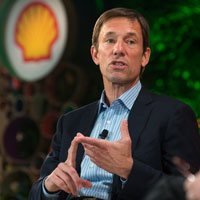
“#MeToo” at the Nature Conservancy
View the page for this story
At $1.3 billion in annual revenues, The Nature Conservancy is among the biggest environmental nonprofits in the world, and in nearly 70 years, it has protected 120 million of acres of land worldwide. But in 2014 it came under fire for allowing oil and gas drilling on protected land, and now the organization is being rocked by a vast scandal, with allegations of workplace misconduct, sexual harassment and discriminatory treatment of female employees. Several senior executives including the CEO have left the organization, and trust in the organization has been shaken. Zack Colman is the reporter at Politico who broke the story, and he speaks to Host Steve Curwood about The Nature Conservancy's current troubles. (09:24)

Beyond the Headlines
/ Peter DykstraView the page for this story
In this week's trip beyond the headlines, Peter Dykstra and Host Bobby Bascomb marvel at the numerous false statements in President Trump’s recent speech on what his administration is doing to protect the environment. Then, the two discuss a Jim Beam distillery disaster that left Kentucky River fish belly-up after swimming in bourbon. Finally, the pair look back to the anniversary of President Jimmy Carter’s ‘Malaise speech’ support for coal gasification and fracking in response to the 1979 energy crisis. (04:12)
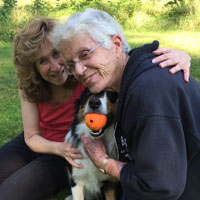
How To Be A Good Creature
View the page for this story
From tarantulas in French Guinea to reclusive, aquarium-dwelling octopuses to the dogs and chickens in her own backyard, naturalist and author Sy Montgomery has connected with creatures all over the globe. They are her friends, her family, and especially her teachers. In her latest book, How To Be A Good Creature, she looks back on the valuable life lessons she’s learned from her friendships with feathered, furred and tentacled animals. Sy Montgomery joins Host Steve Curwood to discuss her treasured memories of these creatures. (14:59)
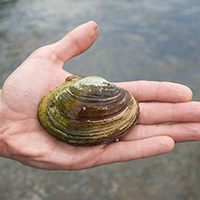
The Secret & Endangered Lives of Freshwater Mussels
View the page for this story
Freshwater mussels are among Earth’s most fascinating and underappreciated species, and sport unique and evocative names like the “spectaclecase”, the “fuzzy pigtoe”, and the “orangefoot pimpleback pearly”. They’re also among the most endangered group of organisms in the United States. Now, in response to legal action by the Center for Biological Diversity, the U.S. Fish and Wildlife Service has agreed to designate critical habitat for four endangered freshwater mussels in 18 states. Tierra Curry of the Center for Biological Diversity tells Host Bobby Bascomb about the enthralling lives of freshwater mussels and why they’re crucial indicators of freshwater ecosystem health. (09:16)
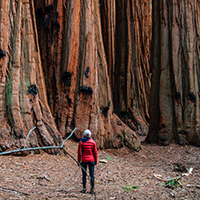
Exploring the Parks: Sequoia and Kings Canyon
View the page for this story
This installment in Living on Earth’s occasional series on America’s public lands takes us to Sequoia and Kings Canyon National Parks in California, which boast some of the biggest trees in the world and the tallest peak in the lower 48 states. Savannah Boiano of the Sequoia Parks Conservancy talks with Host Bobby Bascomb about the highlights of these jewels of the national parks system, including the giant sequoia trees as well as hundreds of miles of hiking trails. (08:40)
Show Credits and Funders
Show Transcript
HOSTS: Bobby Bascomb, Steve Curwood
GUESTS: Savannah Boiano, Zack Colman, Tierra Curry, Sy Montgomery
REPORTERS: Peter Dykstra
[THEME]
CURWOOD: From Public Radio International – this is Living On Earth.
[THEME]
BASCOMB: I’m Bobby Bascomb.
CURWOOD: And I’m Steve Curwood.
Serious sexual harassment trouble at the top for the Nature Conservancy.
COLMAN: Men could basically do no wrong. If there were complaints piling up against senior male leaders, the people above them would protect them from those making the complaints, which was something that was essentially verified through this external report: that the accused are often believed over the accuser.
BASCOMB: Also, endangered little creatures with huge ecological impacts win critical habitat protections.
CURRY: Most people don't even know that freshwater mussels exist. People know that there's mussels in the ocean and cool coral reefs. But in the rivers in the US, especially in the East and Southeast, there's a whole underwater world of mussels and crayfish and beautiful little fish that are just as beautiful as, you know, Nemo and all of his friends.
CURWOOD: That and more this week on Living on Earth – Stick around!
[NEWSBREAK MUSIC: Boards Of Canada “Zoetrope” from “In A Beautiful Place Out In The Country” (Warp Records 2000)]
[THEME]
“#MeToo” at the Nature Conservancy
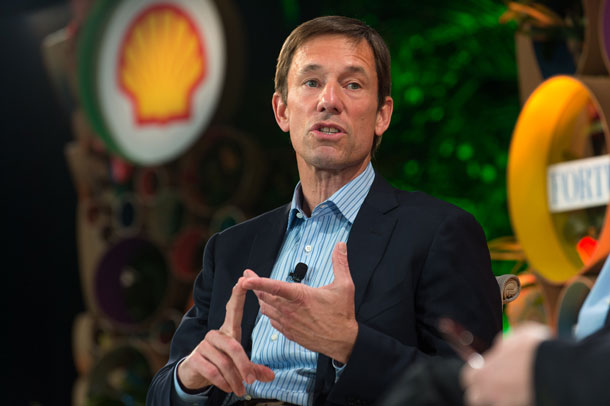
Mark Tercek is the former CEO of the Nature Conservancy, having stepped down following an external report that revealed workplace misconduct and years of allegations of discriminatory treatment of women employees. (Photo: Stuart Isett, Fortune Live Media, Flickr, CC BY-NC-ND 2.0)
BASCOMB: From PRI and the Jennifer and Ted Stanley Studios at the University of Massachusetts Boston, this is Living on Earth. I’m Bobby Bascomb.
CURWOOD: And I’m Steve Curwood. Since its founding in 1951, The Nature Conservancy has protected some 120 million acres around the world, including many key habitats. But sexual harassment and discrimination allegations recently toppled four of its executives, including its $800,000 a year CEO. This is not the first time Nature Conservancy has gotten itself into trouble. Big oil companies have been key donors of cash and land, including an area in Texas donated by Mobil that was intended to protect the endangered Attwater’s Prairie Chicken. But published reports in 2014 documented that the Nature Conservancy allowed drilling for oil and gas on that land and took in millions of dollars in royalties as a result. Zack Colman is an energy and environment reporter for Politico who has been writing about the current problems at America’s largest private conservation organization. Zack, welcome to Living on Earth!
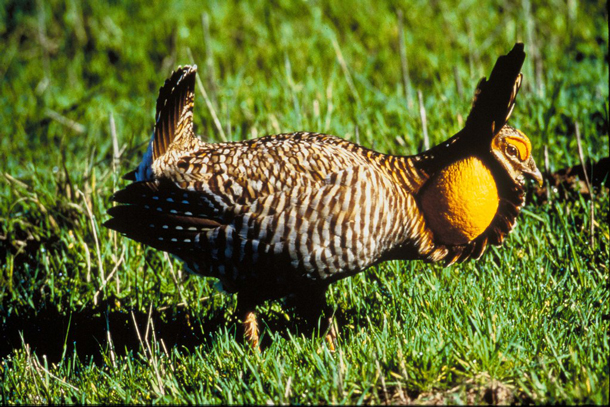
An endangered Attwater's prairie chicken inflates the orange air sacks on the sides of its neck to make a “booming” sound, in a spring mating ritual popular with visitors to the Attwater Prairie Chicken National Wildlife Refuge in Texas. According to a 2014 New York Times report the Nature Conservancy permitted drilling for oil and gas on lands it had promised would be protected as habitat for the endangered bird.(Photo: George Lavendowski / U.S. Fish and Wildlife Service, Flickr CC BY 2.0)
COLMAN: Hey, Steve, thanks for having me.
CURWOOD: Zack. Take us now through the history of the recent troubles with the Nature Conservancy. Some senior people have left. Who are those folks and why are they leaving?
COLMAN: So what happened here is there was an external investigation of the company's culture that was prompted by anonymous tweets from an account that accused the president, Brian McPeek, of sexual harassment. There were a bunch of claims made. One was found credible, and there was an exhaustive list of company cultural issues tied to gender discrimination, alcohol served at work functions, people accusing higher ups of harassment and discrimination but not being believed when those accusations were made. All of this was documented in a report and it was sent out to staff. The CEO of the Nature Conservancy, Mark Tercek said, despite all this we're going to keep the president, Brian McPeek on, and have a good day. That didn't go over well. After that, it all unraveled. The staff did not have confidence in Brian McPeek's ability to lead. McPeek resigned a day later. Tercek's ability to hold on to his job became questioned. And he left a week later.
CURWOOD: Now, Zack, I'm just scratching my head a bit here, because while sexual harassment is not good in any organization, it seems to me much more must be going on here.
COLMAN: Much more is going on. It's one of those things where this company's culture had become so corrosive for women employees in particular. There was just a sense that women were not listened to, that women had such different standards for advancing, that there was rampant discrimination, and that women had differing expectations for success. There was actually, months before this, an internal investigation by the company's Gender Equity Advisory Council, which listed a whole bunch of recommendations, surveyed men and women within the company. And women said that they felt it was, quote, a "good old boys club". And that the onus was on women to find a way to succeed in a male dominated workforce. That's what the men said at the company. So there are just widespread cultural issues here. The women in that survey said change must start at the top. And this is the type of behavior and culture that was ignored for years.
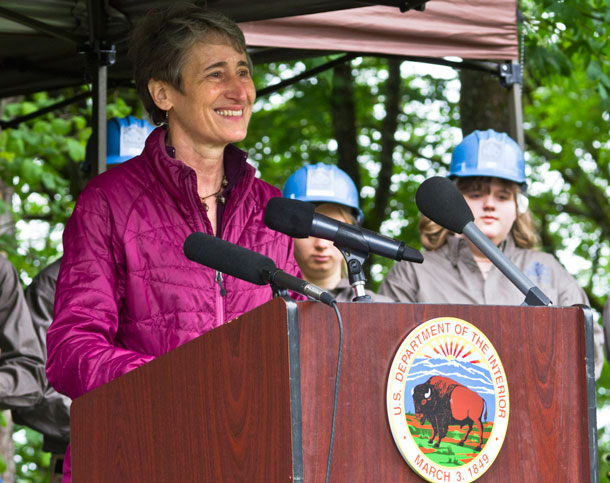
Sally Jewell is the former US Secretary of the Interior under the Obama Administration, and former CEO of REI Coop Outfitters. She has been named interim CEO for the Nature Conservancy, starting September 3, 2019. (Photo: Matt Christenson, Bureau of Land Management, Flickr, CC BY-SA 2.0)
CURWOOD: The former CEO Mark Tercek joined the Nature Conservancy, essentially from Wall Street. He'd been at Goldman Sachs, he was an investment banker. That's, you know, to certain extent, the good old boys. Why did the Nature Conservancy think that he would do anything else but continue the culture of the investment banking world?
COLMAN: Well, keep in mind this was in 2008, when he came. This is nine years prior to what we now know as Me Too. It's not to say that there weren't people talking about these issues back then. But it certainly didn't have the relevance and resonancy that it has today. So Mark Tercek got brought on when Congress was debating cap-and-trade legislation. He comes in with this business-minded outlook on the environment at a time when Congress is taking very much a business-minded, private sector approach to the environment as well. He comes in, bringing all these financial mechanisms, this promise to work with corporations. And for business, it worked out for him, and it worked out for the Nature Conservancy. When he stepped in, the Conservancy had revenues of $537 million in his first full year, in 2009. Last year's filings: $1.3 billion in revenue. So he did grow the business. And that was what they wanted to do. He saw these challenges of climate change and environmental degradation as being so big and the Nature Conservancy's scope and worldview too small.
CURWOOD: Zack, when you when you speak with people at the Nature Conservancy, how do they feel about the changes that have been made, since Messrs. Tercek and McPeek have stepped down?
COLMAN: Honestly, the amount of people who have reached out to me, to thank me for my reporting, and to say there's still a lot of work that needs to be done, it's kind of overwhelming. Because you talk to these people who have been there, who worked for the Nature Conservancy, who still work for the Nature Conservancy. And you know that this goes deep, this cultural issue of women being ignored, having different standards, being harassed. I talked to someone who said that men could basically do no wrong. If there were complaints piling up against senior male leaders, the people above them would protect them from those making the complaints, which is something that was essentially verified through this external report, where one of the conclusions was, that the accused are often believed over the accuser, and that the HR and compliance system was absolutely broken. And people that I talked to, are happy that these issues are finally getting attention, both within the company, but also in the press, and they're excited about this change. They said it was a long time coming. And the thing that's crazy is a lot of these people have been there for five, ten, twenty years, even. And they stuck with it because they believe in the organization's mission. And they believe that corralling corporations and business is an important way to make progress on the environment, because we're just not going to drop these corporations tomorrow. That's unrealistic. But they endured so much to achieve that mission. And they just want it to be a better place that does better by its people.
CURWOOD: So from what you've gathered, what changes are the folks at the Nature Conservancy hoping will be made now?
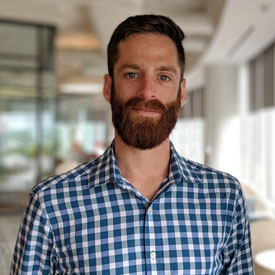
Zack Colman is an energy and environment reporter for Politico. (Photo: Courtesy of Politico)
COLMAN: Well, they know that the work's not done, and they're bringing in interim CEO Sally Jewell, who was the Obama Administration's Interior Secretary in Obama's second term. And they're concerned that by bringing in Sally Jewell, the Nature Conservancy will be complacent. That that is enough. That she's a good enough figurehead, and that they'll just do some rudimentary, sort of, culling of people, maybe. Changing some processes in a superficial way. They know that a deep cultural shift is what needs to happen.
CURWOOD: So what does the future look like for the Nature Conservancy? How will these complaints, and this conflict affect donations do you think?
COLMAN: That's definitely something that people are concerned about. People are concerned that this reputational damage will keep money on the sidelines. I've talked to fundraisers within the organization who say, look, you can't go into an environment with the kind of albatross we have around our necks and get public facing companies to put their name next to us. You can't get them to open their wallets for us when they have so many safer plays they can park their money at. I've contacted a bunch of the funders. I didn't get any comment from JP Morgan, one of the board members from the Nature Conservancy is on JP Morgan's executive team. I got no comments from Shell, I got no comment from BP. Those are some pretty big funders and they're ones that you would think would like to be next to an environmental organization. How many environmental organizations are going to willingly work with BP and Shell? And yet they won't say whether they're going to continue their commitment. I think that's cause for concern. Normally, if you're okay with an organization, you'll say so. The fact that they're not saying something means that they're still probably looking at what their strategy will be going forward with respect to the Nature Conservancy. It's also one of those organizations that's, sort of, too big to fail. It will continue. Whether it drives $1.3 billion in revenue again, I'm not sure. But those fundraising metrics get set up on an escalating scale, you always want to do more than you did the year before. So, that's what a lot of people are concerned about, right now at the organization is, can we keep doing what we were doing? And it seems like that's in jeopardy.
CURWOOD: Zack Colman is an energy and environment reporter for Politico. Zack, thanks so much for taking the time with me today.
COLMAN: Thank you for having me.
Related links:
- Politico | “‘The System Was Broken’: How the Nature Conservancy Prospered but Ran Aground”
- Politico | “2 Executives Depart Nature Conservancy After Harassment Probe”
- Politico | “Nature Conservancy’s Caribbean Program Chief to Exit After Probe”
- The Nature Conservancy | “The Nature Conservancy Announces Board and Leadership Appointments”
- The New York Times | “Nature Conservancy Earns Oil Income Despite Pledge on Drilling”
- The Nature Conservancy website
[MUSIC: Joseph Breznikar, “Four Hymns: Were You There?” on Cascade: A Rhapsody For Guitar & Chamber Orchestra, traditional American folk hymn/arr. Joseph Breznikar, self-published]
Beyond the Headlines

On July 8th, 2019 President Trump delivered a speech on his environmental accomplishments. (Photo: Gage Skidmore, Flickr, CC BY-SA 2.0)
BASCOMB: It's time for a trip now beyond the headlines with Peter Dykstra. Peter's an editor with Environmental Health News, that’s EHN.org and DailyClimate.org. Hey there, Peter, what do you have for us this week?
DYKSTRA: Hi, Bobby. We're going to start with a midsummer night's hallucination from, who else, President Donald Trump. It's not just crowd size anymore that he tends to stretch the truth. On Monday, he made some remarks about his administration's environmental achievements. It came very, very close to not having a single thing he said to be truthful in any way.
BASCOMB: Well, give us an example. What did he have to say?
DYKSTRA: Well, the President said he was right about his analysis on the cause of California’s bad wildfires last year. That managing the forest floor was key. Even though the biggest fires were started off of federal land where they couldn't be managed. Remember that he also said that Finland prevents its fires by raking the forest floor.
BASCOMB: I think I remember Finland saying that they've never raked a forest floor. You know, and speaking of fire, I read this quote from the Union of Concerned Scientists. They said, "President Trump touting his Environmental record is like an arsonist talking about how valuable his work is to the fire department."
DYKSTRA: Oh, it is a job creator for the fire department. But, Trump also said that the US is number one in fighting air and water pollution, even though those numbers are demonstrably false by those who keep statistics. He bragged about crystal clear air and water. He said the US has the best drinking water, and on that one, he may actually be right according to a global index produced by Columbia and Yale Universities.
BASCOMB: And, of course, not mentioned, there was a pretty big elephant in the room.
DYKSTRA: An elephant called climate change. Didn't mention a thing about that. Although, he did mention that the US is now the world's biggest oil and gas producer.
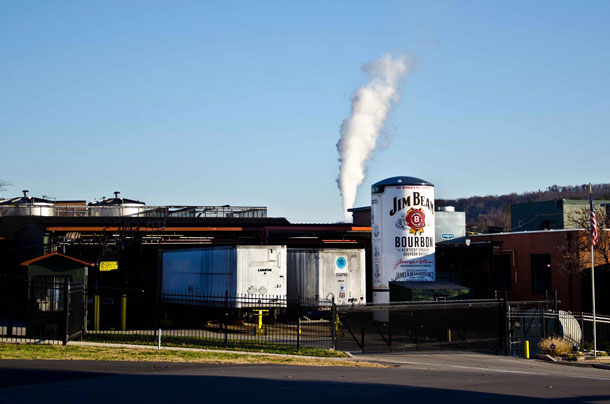
45,000 barrels were set ablaze during a fire at a Jim Beam warehouse in Kentucky. (Photo: Jamie Bernstien, Flickr, CC BY-NC-ND 2.0)
BASCOMB: Wait a second. That's an environmental accomplishment?
DYKSTRA: Well, it might be to his EPA Administrator and his Interior Secretary. Andrew Wheeler at EPA is a former coal lobbyist. David Bernhardt at the Interior Department is a former oil lobbyist.
BASCOMB: Hmm, this doesn't seem like much of an environmental record to really be bragging about, especially with them on his side.
DYKSTRA: Uh, are you calling it fake news?
BASCOMB: [LAUGHS] I guess if the shoe fits. Well, what else do you have for us this week?
DYKSTRA: Tragic news from Kentucky. The Kentucky River was absolutely littered this past week with dead fish in the wake of a huge fire at a Jim Beam bourbon warehouse.
BASCOMB: Ah. So, the fish went belly up from too much booze?
DYKSTRA: Belly up from too much booze. Depending on which is the bigger tragedy, the loss of bourbon or the loss of wildlife. Either way, it's not the first time that there’s been a massive alcohol spill into a waterway.
BASCOMB: Oh, really? When else has this happened?
DYKSTRA: About 10 years ago, there was a truckload of scotch that dumped into a river in, where else, Scotland. And, about 50 years ago in Newark, New Jersey, the Ballantine brewery there, dumped basically a day's batch of beer into the Passaic River. The river had a head on it for a full day. Seagulls were reportedly diving into the foam and then smashing into buildings after getting a seagull’s belly full of beer.
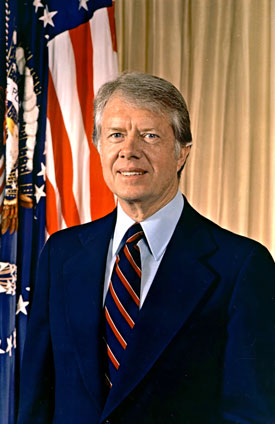
39th US President Jimmy Carter installed solar panels on the White House roof during his time in office. (Photo: Wikimedia Commons, CC)
BASCOMB: Oh, man. Well, what do you have for us from the history vaults this week?
DYKSTRA: Here's a 40th anniversary. On July 14, 1979, and in response to the second energy crisis in the 1970s, President Jimmy Carter proposed an $85 billion synthetic fuel development program featuring coal gasification, making natural gas from coal, and tapping what was then called shale gas, which we now better know as fracking.
BASCOMB: That doesn't seem like a very good idea if you're concerned about climate change.
DYKSTRA: Certainly need to give Jimmy Carter credit for having the foresight to also tout renewable energy, wind and solar. Although, that clearly had very little impact since it's 40 years later and wind and solar on a large scale are just now getting off the ground.
BASCOMB: All right, Peter. Well, thanks for that! Peter Dykstra is an editor with Environmental Health News. That's EHN.org and DailyClimate.org. We'll talk to you again real soon.
DYKSTRA: All right, Bobby, thanks a lot. Talk to you soon!
BASCOMB: And there's more on these stories on our website, LOE.org.
Related links:
- The New York Times | “Trump’s Misleading Claims About His Environmental Record”
- Politico | “Finnish president denies ever discussing ‘raking’ with Trump”
- BBC | “Thousands of dead fish in Kentucky river after Jim Beam warehouse fire”
- NPR | “Examining Carter's 'Malaise Speech,' 30 Years Later”
[MUSIC: Earl Wild, “7 Virtuoso Etudes: Fascinatin’ Rhythm” on Great Pianists Of the 20th Century: Earl Wild – The Art Of the Transcription, by George Gershwin/Earl Wild, Philips Classics]
BASCOMB: Coming up – Tips for how to be a good creature from some good creatures. That’s just ahead on Living on Earth.
ANNOUNCER: Support for Living on Earth comes from Sailors for the Sea and Oceana. Helping boaters race clean, sail green and protect the seas they love. More information at SailorsfortheSea.org.
[CUTAWAY MUSIC: Earl Wild, “7 Virtuoso Etudes: Fascinatin’ Rhythm” on Great Pianists Of the 20th Century: Earl Wild – The Art Of the Transcription, by George Gershwin/Earl Wild, Philips Classics]
How To Be A Good Creature
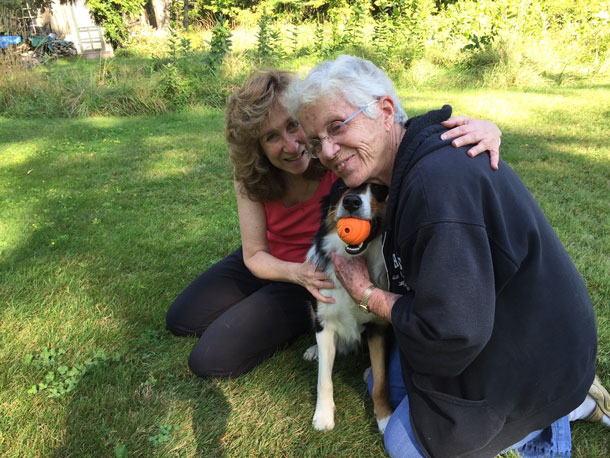
Sy Montgomery (left) poses here with her beloved Border Collie Thurber and friend and occasional writing partner Elizabeth Marshall Thomas at Sy’s New Hampshire farmhouse. (Photo: Steve Curwood)
BASCOMB: It’s Living on Earth, I’m Bobby Bascomb.
CURWOOD: And I’m Steve Curwood.
Author and long-time friend of Living on Earth Sy Montgomery wrote the New York Times Best Selling memoir, How To Be A Good Creature. In it, Sy tells us exactly that. And who knows better than Sy how animals can teach us how to be good inhabitants of the world? From tarantulas in French Guinea, to reclusive aquarium-dwelling octopuses, to dogs and chickens in her own backyard, Sy has connected with creatures all over the globe. They are her friends, her family, and especially her teachers. Joining us now from her home in Hancock, New Hampshire, is author Sy Montgomery. Now, this book is a memoir that really talks about some 13 different creatures that have taught you how to be a good creature. And you start your stories with Molly, the dog.
MONTGOMERY: I'm looking at her picture right now on my desk. Yeah, Molly. Molly was essentially the older sister I never had. I mean, most little girls idolize their older sisters. I never had any siblings but I had something better. I had a Scottish terrier and even though she was chronologically younger than I was, I was very aware that dogs mature earlier than we do. They become adult in just a few years. We take, you know, 15, 18, 21 years to mature. But Molly was a fierce, strong, independent, wonderful, wise, adult individual. And I wanted to be just like her.
CURWOOD: Ah, your dog taught you to grow up to be a strong woman.
MONTGOMERY: Yes, she did. She totally did. And I used to dream of the day that I could run away with Molly, and live in a hollow tree or live in the woods somewhere, that with her, I'd be able to learn the secrets of the animals who lived in the wild. And that's what I went on to do.
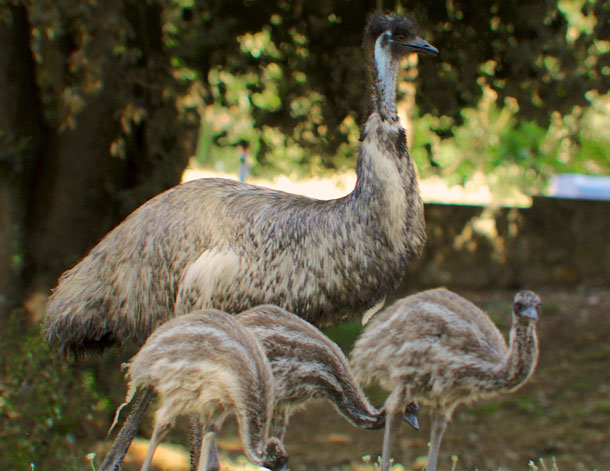
After her initial visit with the citizen science group EarthWatch, Sy Montgomery returned to the Australian Outback where she studied a trio of emus, like those seen above for an extended period. (Photo: Greg Scales, Flickr, CC BY 2.0)
CURWOOD: Now, in your book, you recount your career, and it seems like you're well on your way to being the journalist, a little girl had a newspaper, and grown-up woman has job as a reporter, and you're all set to go, and then, well, something happens along the way.
MONTGOMERY: Well, my father, ever my champion, gave me the gift of a trip to Australia, and I didn't want to just go as a tourist. I wondered if there was some way that I could volunteer or do a study or, you know, help a scientist. And there was. There's an organization, as you know well, called Earth Watch. You can spend a couple of weeks helping a scientist almost anywhere in the world. So, I looked to see what they had in Australia. And what they had in Australia was a project called “drought refugia.” And this was a study with Dr. Pamela Parker of the Southern Hairy-Nosed Wombat. Now, who can resist that? Almost nothing was really known about them until Dr. Parker came along. So, for a couple of weeks we lived in tents in the Outback and by day we would try to find the wombats. And I was crazy about this. I had the best time and I worked really hard, and afterwards, Dr. Parker was impressed enough to say, Sy, I wish I could hire you to work for me. I wish I could buy you a ticket to come back and Australia, but I can't. But what I can do is, if you ever wanted to come back on your own, I'd let you stay at my camp and you could eat my food. So, I went back to my wonderful job. And I quit that job and moved to a tent in the Outback. And I studied emus.
CURWOOD: And, you write that the emus really taught you something important, what was that?
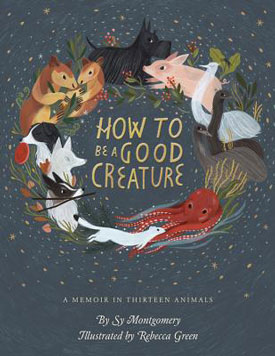
Sy Montgomery’s book, How To Be A Good Creature: A Memoir in Thirteen Animals, is a New York Times Best Seller. (Photo: The Toadstool Bookshop)
MONTGOMERY: They showed me a lot. I mean, I certainly learned a lot of field work knowledge from them, but the most important thing, Steve, it was that doing the science, doing the reading, all that intellectual stuff really matters. But, if you want to understand an animal, you also have to bring to that understanding your heart. I let them choose to be around me, and I wouldn't approach them so closely that they would feel frightened. The minute that they seemed upset I’d just back off and stay still. You know, at first I thought, I'm gathering important scientific data. This is really fun. And the data is important and taking notes is important. But the more I follow, the more I was with them. I found myself falling in love with them. And there were times that I realized that taking the notes wasn't the most important thing I was doing. Maybe the most important thing I was doing was falling in love.
CURWOOD: Indeed. Now, you're a writer, and so, there's always the editing process. Just how difficult was it for you to whittle your stories down to just 13 animals in 10 chapters?
MONTGOMERY: Well, I did leave out some important animals in my life, and they very much still animate my life. But the ones that I included in this memoir, it's a memoir in 13 animals, that’s the subtitle, are ones that taught me very specific lessons for my life about how I should perceive the world and how I should behave. And I chose those that best illustrated that. Some of the animals taught me how to cope with loss. Some animals taught me how to find your destiny. One animal showed me how to forgive, and Thurber showed me that there's always something wonderful lurking right around the corner that you can't possibly anticipate.
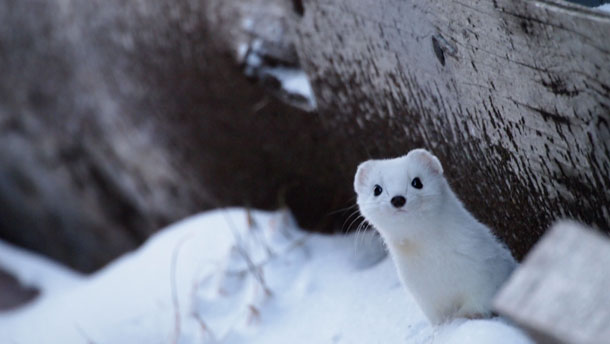
One of the lessons conveyed in Sy’s book was that of forgiveness, inspired by her forgiveness of an ermine that had killed one of the chickens she kept. (Photo: Fiona Paton, Flickr, CC BY-NC-ND 2.0)
CURWOOD: Talk to me about how a creature taught you to forgive.
MONTGOMERY: Well, this was an ermine. They are the white-coated version of weasels, who live in the north. So, this weasel, ermine, who I met, I met on Christmas morning. And every Christmas morning I always make my hens a big bowl of delicious hot popcorn. And I was carrying it down to give to the ladies. And one of my girls was lying dead on the floor of the coop. And someone had a hold of her head. And when I pulled her away, this white head popped out from the corner with coal black eyes. It was a tiny little critter. This animal probably weighed less than a handful of coins, but so fierce, and I could not be mad at that weasel. I mean, the animal had just killed someone who I loved and it was Christmas morning and you’d think that would make you really angry or that you might even hate someone who did that. But that wasn't what I experienced at all. What I experienced was the glory of this creature, the glory of its wildness, and its ferocity, and its determination, and its courage, its braveness. And I thought about my mother. And my mother had just died, oh gosh, that very year. But throughout my childhood and growing up and even as an adult, we'd had a number of disagreements and, at one point, my parents had disowned me for marrying the love of my life, Howard Mansfield. We had a lot of disagreements, but in the moment that I beheld that ermine, I just felt this wave of forgiveness sweep over me for my mother. And I realized that she was fierce like that weasel, she shared a lot of the characteristics of that ermine, and there was so much in her to admire, and I realized how much I loved her, and how much I missed her.
CURWOOD: Now, you write about octopuses, in fact, a little shout out about us at the show when we went to meet one of your octopus friends at the New England Aquarium. How did you get into, well, talking and being with octopuses?
MONTGOMERY: The first octopus I met, I went in with an assignment for Orion Magazine on the intelligence of octopuses. And one of the keepers opened up the tank where Athena lived. And this huge animal, I mean, her arm span had to have been, oh, gosh, nine, ten, or more feet. She turned bright red with emotion. She slid from her lair, looking me straight in the eye with hers, and then out from the cold, 47 degree water come boiling up her arms, reaching for me with these questing suckers. So, naturally, I plunged my hands and arms right into the water to greet her. And the next thing I knew, I was patting her head. And she was just as curious about me as I was about her. And I came back several times to meet her. But the thing about octopuses is, they just don't live very long. And after only a few visits, I got the horrible news that she just died of old age. So, the next octopus who came, they invited me back to meet her, and that's the octopus, who you met, Steve, Octavia. And there's a chapter in this book about Octavia. And when I introduced you to Octavia, only once before had we had a close interaction. So, I really wasn't sure what she was going to do when she met you. But she was quite brilliant. She was interacting with you, and the producer, and the sound person. And while we were all petting, and feeding, and watching this octopus, just our senses being flooded with the sensation of touching this beautiful animal, feeling her suckers watching her change color right out from under our noses, she stole a bucket of fish, do you remember that?
CURWOOD: [LAUGHS] I do.
MONTGOMERY: [LAUGHS] She totally outwitted us.
CURWOOD: [LAUGHS] You know, I have to confess I was a bit fearful. I mean, I hadn't met an octopus before.
MONTGOMERY: Right. And they're depicted as monsters in all kinds of literature, and paintings, and etchings.
CURWOOD: Yeah, when I reached in their first there was one sucker, and then there were several suckers, and everything attached. But thanks for you being there, I simply relaxed. But when I heard that she too died of old age and motherhood, I was sad.
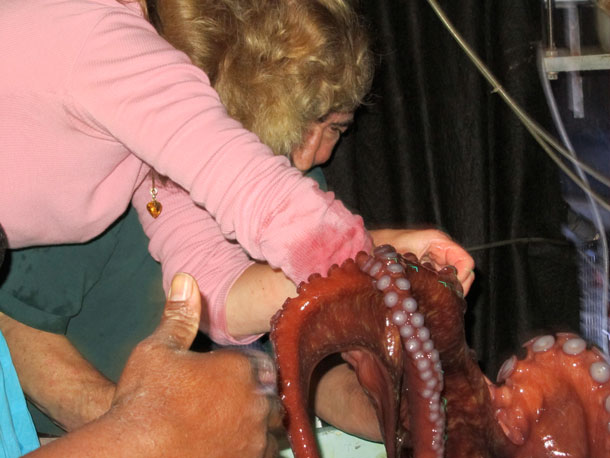
Octavia rises out of her tank to greet Sy. (Photo: Living On Earth)
MONTGOMERY: I know, I know, they just break your heart. But I knew her more intimately than any other octopus, because I knew her pretty much from when she first showed up at the aquarium until she died. And it was just so beautiful to be able to see the full arc of her life. And the last thing a mother octopus does is tend for their eggs. And even though her eggs were infertile, she tended them with all the tenderness and love that a mother octopus would feel for living eggs. And that was a real blessing to be able to see.
CURWOOD: Now you, I think you struggle at times with making sure to not anthropomorphize the animals in your stories. But you also make the point that, perhaps the worse mistake is to assume that animals are emotionless, that they don't have emotions.
MONTGOMERY: Exactly, exactly. What we don't want to do is project our feelings onto other animals, or other people. And so, and, we can't help it sometimes, you know, we can easily imagine that an animal wants to be petted, and when maybe it doesn't. That's a common mistake. But more dangerous, as you said, is to think that they don't have thoughts or feelings, thoughts and feelings are not human things alone. We're part of a huge family of living creatures, and consciousness does not belong to us alone. Emotion does not belong to us alone. These are things that are helpful to animals to let them live. So, we do ourselves and the creatures a terrible disservice to assume that they are thinking nothing, that they are feeling nothing, that they know nothing, that they do not make decisions. We will never understand the lives around us unless we realize that animals are thinking, feeling, knowing beings.
CURWOOD: So before you go, Sy, what do you hope to impart to animal loving listeners, or even those whose relationships with animals may be a little more tenuous or even skeptical?
MONTGOMERY: Well, I would want to say that we are embedded in this glorious world of other souls, other minds, and these others have so much to teach us. And being surrounded by teachers in a confusing and difficult world should make us feel far more at home here, and far more in love with our homes, and give us the courage to fight for this beautiful Earth that is so imperiled, and so alive.
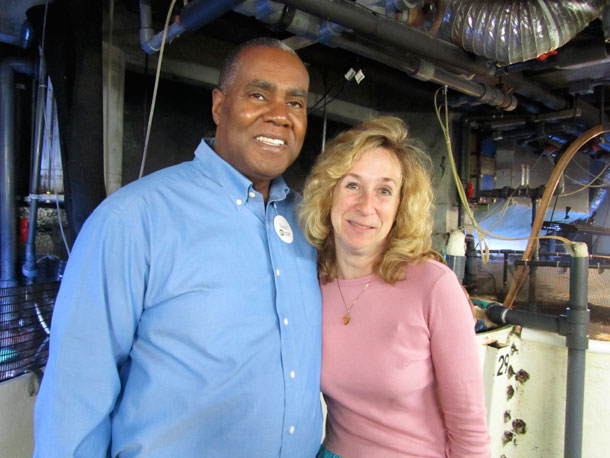
Host Steve Curwood and Sy in 2011, on a visit to Octavia the Octopus at the New England Aquarium. (Photo: Living On Earth)
CURWOOD: Sy Montgomery's book is called How to Be a Good Creature: A Memoir In 13 Animals. Sy, thanks so much for taking the time with us today.
MONTGOMERY: Oh, such a pleasure, Steve.
BASCOMB: So, Steve, did Sy convince you animals are conscious and aware?
CURWOOD: Well, my dog Jilly already has. I have to spell the word food, because if I say it, she heads for her bowl and gives me the look.
BASCOMB: Yeah, I know that look.
CURWOOD: And by the way, if anyone would like to hear Sy Montgomery speak about being a good creature, and you’re in the Boston area on July 18th you can catch her that evening at the New England Aquarium. For more information, find this story on the Living on Earth website, LOE.org
Related links:
- Learn about Sy’s July 18, 2019 lecture at the New England Aquarium here
- Sy Montgomery’s website
- How to Be a Good Creature: A Memoir in Thirteen Animals
- Our interview with Sy Montgomery and Elizabeth Marshall Thomas from 2017
- A Previous LOE story where we met Octavia, the Giant Pacific Octopus
[MUSIC: Bob Moses, “Elegant Blue Ghosts Dance Like Clouds Over Main Street U.S.A.” on Time Stood Still, by Bob Moses, Gramavision (Distributed by Rhino Records)]
BASCOMB: Coming up – tips for finding a hidden jewel in Central California. Hint: it’s a spectacular national park. That’s just ahead on Living on Earth.
ANNOUNCER: Funding for Living on Earth comes from you, our listeners, and United Technologies, combining passion for science with engineering to create solutions designed for sustainability in aerospace, building industries, and food refrigeration. UTC companies such as Otis, Carrier, Pratt and Whitney, and UTC Aerospace systems are helping to move the world forward. You can learn more about United Technologies by tuning into the Race to Nine Billion podcast; listen at racetoninebillion.com. This is PRI, Public Radio International.
[CUTAWAY MUSIC: Bob Moses, “Elegant Blue Ghosts Dance Like Clouds Over Main Street U.S.A.” on Time Stood Still, by Bob Moses, Gramavision (Distributed by Rhino Records)]
The Secret & Endangered Lives of Freshwater Mussels
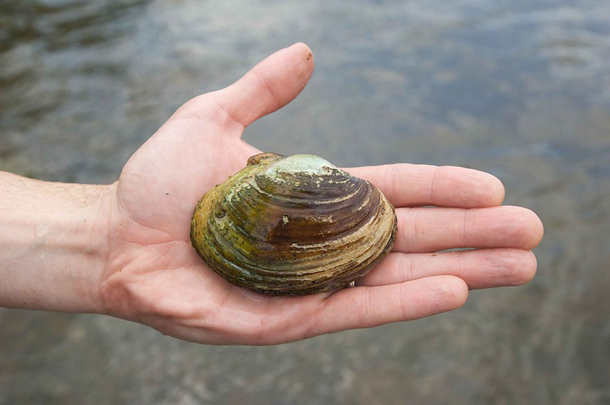
A freshwater mussel of the genus Lampsilis (Photo: Westcott Phillip, U.S. Fish and Wildlife Service, Wikimedia Commons, Public Domain)
CURWOOD: It’s Living on Earth, I’m Steve Curwood.
BASCOMB: And I’m Bobby Bascomb.
The U.S. Fish and Wildlife Service recently protected critical habitat for four species of endangered freshwater mussels. The mussels have been protected as endangered since 2012, but nothing had actually been done to actually protect their habitat, until the Center for Biological Diversity stepped in with a lawsuit six years later. Freshwater mussels may not at first glance be the most charismatic critters, but they do play a critical role in the streams, lakes, and rivers they call home. Here to tell us more is Tierra Curry, a Senior Scientist with the Center for Biological Diversity. Welcome back to Living on Earth, Tierra!
CURRY: Thank you so much, I couldn't be more excited to talk about freshwater mussels.
BASCOMB: And by the way, congratulations on getting this mussel habitat protected.
CURRY: Thank you so much. It's gonna protect mussels in 18 Eastern states. So it's a really big deal.
BASCOMB: These are freshwater habitats, right?
CURRY: Right. Like, most people don't even know that freshwater mussels exist; people know that there's mussels in the ocean and cool coral reefs. But in the rivers in the US, especially in the East and Southeast, there's a whole underwater world of mussels and crayfish and beautiful little fish that are just as beautiful as, you know, Nemo, and all of his friends.
BASCOMB: [LAUGHS] So first of all, why should people care about freshwater mussels, if most people, as you said, have not even heard of them? Why should we care, what makes them important or special?
CURRY: They are the coolest, most important, and most underappreciated, and most endangered animals in North America. They really embody the health of the rivers. I mean, our fate is tied to the fate of freshwater mussels. Whether they live or survive tells the story of whether or not we're doing a good job taking care of our creeks and rivers. And currently, we're really not. So in a nutshell, that's why people should care, or I guess I should say in a mussel shell!
BASCOMB: [LAUGHS] In a mussel shell. So, what's cool about them? Give me some fun facts.
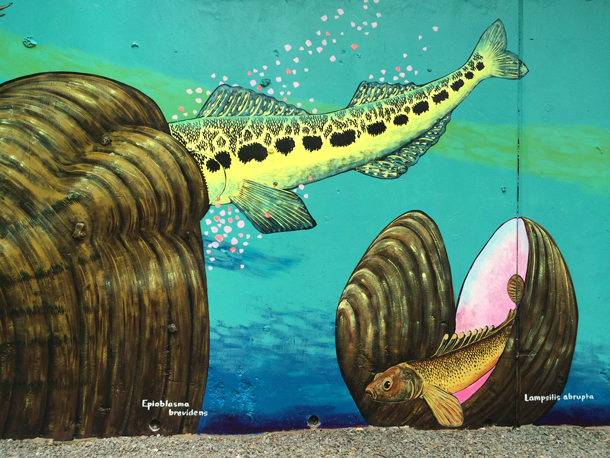
In this mural painting by artist Roger Peet, the Cumberlandian combshell (Epioblasma brevidens) mussel expels larvae into a host fish. (Photo: Center for Biological Diversity)
CURRY: Everything is cool about them. So, they can live for hundreds of years, making them one of the longest-lived invertebrates. They have wonderful names like the fuzzy pigtoe, and rough rabbits foot, and delicate spike, and each one of them is kind of individual. If you didn't know about them, and you saw them on the river bottom, you'd probably just think they were a rock, but each species has a unique method of reproduction, and a cool name, and different colors and patterns, just beautiful elegant shells with bumps or ridges. The four that we just got an agreement with the US Fish and Wildlife Service to protect critical habitat for, are the snuffbox, sheepnose, spectaclecase, and rayed bean.
BASCOMB: Now you sound pretty excited about freshwater mussels, pretty passionate about them. What draws you to these little creatures so, so strongly?
CURRY: They're absolutely my favorite species because each one of them has an individual story and a colorful shell and shape. They're kind of like the Garbage Pail Kids collectors cards that were around when I was a kid, like I think of each one of them as an important individual that's a total weirdo. Like, my favorite one is called the orangefoot pimpleback pearly mussel, and it's really endangered. It's found in Kentucky and Tennessee. My coworkers one year, we were at work retreat and my birthday happened to fall that week. And they held a surprise party for me with the theme "endangered but not extinct freshwater mussels of Kentucky". And so they all dressed up as different mussels. There was a spectaclecase, and a sheepnose, and a snuffbox, and one of them dressed up as the orangefoot pimpleback pearly mussel, it was super fun.
BASCOMB: [LAUGHS] You are a wild and crazy bunch there at the Center for Biological Diversity!
CURRY: [LAUGHS] It was the best party ever.
BASCOMB: And freshwater mussels, do they serve the same function in the ecosystem as saltwater mussels? That is, you know, filtering the water?
CURRY: Yes. So just by breathing and feeding, freshwater mussels pull bacteria and algae and pollutants from the water column. And they take that material that wouldn't be food for other organisms, and they turn it into a food source, because lots of things like to eat freshwater mussels, including turtles and river otters. In fact, some of the endangered turtles in the Eastern US, when they worked to replenish the freshwater mussel populations and clean up the rivers, then the turtles bounced back as well, because they're such an important food source.
BASCOMB: So they really serve an important function, then, in their ecosystems.
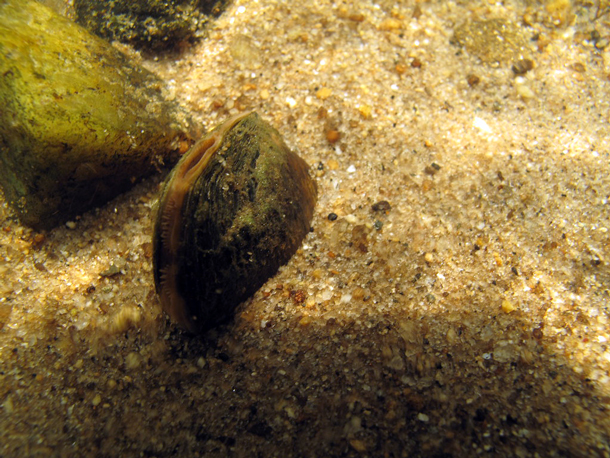
An Appalachian elktoe mussel in a North Carolina streambed. (Photo: Gary Peeples/USFWS, Flickr CC BY 2.0)
CURRY: Yes, and even their shells are important. When the mussels die and their shells are still on the river bottom, other animals can use them as habitat, like darters or small colorful fish in the Eastern US, and the darters will hang out in the mussel shells.
BASCOMB: And I would think being a filter feeder and filtering out the pollution in the water, as you mentioned, probably makes them pretty vulnerable.
CURRY: Absolutely. That's one of the biggest reasons that they're the most endangered group of organisms in the US. 70% of them are at risk of extinction and 38 have already been lost. So, they store the pollutants in their bodies. And also, early on, they were collected for use as buttons. So before there was plastic, there were these huge button factories that collected freshwater mussels to make buttons and jewelry and mother-of-pearl items. And so over-collection was an early threat. And then as that industry declined, we started damming all the rivers. And so dams have had terrible effects on freshwater mussels. And unfortunately, we're still fighting proposals for new dams in the Eastern US to this day, we haven't learned our lesson about them yet.
BASCOMB: I understand that they also have a pretty unique life cycle in the way that they reproduce. Can you tell me about that?
CURRY: Oh, my gosh, it's so cool. So there's a couple different strategies that mussels use. The rayed bean, which is one of the species that is going to get critical habitat, it makes this lure that sticks out of its little mussel shell and flaps its mantle around to attract very specific fish. So the rayed bean is trying to attract the rainbow darter or the Tippecanoe darter. These small fish, they swim up to it, and then it claps onto them and expels its fertilized eggs onto their gills. So the perfect little baby mussels develop on the fish's gills, and then the fish swims away and the mussels drop off somewhere. And, like, the snuffbox, it has to catch a fish called the common logperch to be able to reproduce. So all the mussels in the US are dependent on fish hosts except for one, the salamander mussel uses a big salamander called the mud puppy. But because of that intricate relationship, anything that threatens the fish hosts also threatens the mussels. And dams can separate mussels from their fish hosts.
BASCOMB: So what is the federal government doing to protect endangered freshwater mussels?
CURRY: Not enough. So even though they're the most endangered group of animals in the country, and a lot of them are protected under the Endangered Species Act, they just don't get the recovery money that they need. Some of them don't get any recovery money, some of them get less than $100 a year. So one of the positive things that has happened is Representative Grijalva, the Chairman of the House Natural Resources Committee, has introduced a bill called the Extinction Prevention Act of 2019. And this Act would designate funding to protect four really endangered groups of animals, including freshwater mussels. So it would give $5 million a year for five years specifically to freshwater mussel propagation and recovery. And that would be amazing because the technology exists to save these mussels. But there just isn't the funding.
BASCOMB: What's going on in the Trump administration in terms of mussel habitat protection?
CURRY: The Trump administration is working really hard to weaken every single aspect of the Endangered Species Act, from getting on the list, to recovery, to what critical habitat designation means. And so, one of the proposed changes that they're making to the Endangered Species Act would mean that for critical habitat to be considered to be adversely modified, so for a project to hurt the critical habitat, which they're not supposed to be allowed to do, they're changing the definition so that all of the critical habitat would have to be harmed by the project, and not just part of it. And for these mussels that occur across the Eastern US, that would basically mean that a meteor would have to wipe out the eastern half of the United States before it would adversely modify their habitat. So any projects, like putting a pipeline across a river, is going to create a ton of sediment and the risk of a chemical spill. Not a good idea. But under the Trump administration definition of adverse modification, the pipeline would have to pollute all of their rivers at the same time and not just one of their rivers.
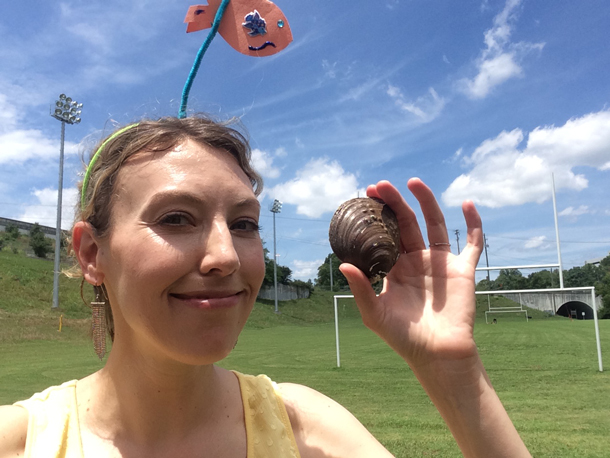
Tierra Curry with an orangefoot pimpleback pearly mussel shell. (Photo: Center for Biological Diversity)
BASCOMB: Well, what can our listeners do to help these little bivalves?
CURRY: Anything that people can do to help keep the water clean around them, like using less pesticides, less fertilizers; planting trees along streams so that dirt from projects doesn't run into the stream, reporting that sort of thing. Everything that helps clean water is going to help the mussels. And climate change is one of the biggest growing threats to freshwater mussels because the young mussels have very specific temperature limits. And so as rivers become warmer, and as drought affects areas, the mussels won't be able to reproduce. And that's another way that people can help save them, is taking action to address the climate catastrophe.
BASCOMB: Tierra Curry is a senior scientist with the Center for Biological Diversity. Tierra, thank you so much for taking the time to talk about mussels with me.
CURRY: Thanks so much, Bobby.
Related links:
- More about freshwater mussels
- Press release: “Endangered Mussels to Gain Protected Habitat in 18 Eastern, Midwestern States”
- WATCH: “The Fascinating and Endangered Sex Lives of Freshwater Mussels”
- Extinct Freshwater Mussels of the American Southeast
- WATCH: The natural fish lure of the lampsilis mussel
- Tierra recommends: “Immersion: The Science and Mystery of Freshwater Mussels”
[MUSIC: Sharon Jones & the Dap-Kings, "This Land is Your Land" on Naturally, Daptone Recording Co]
Exploring the Parks: Sequoia and Kings Canyon
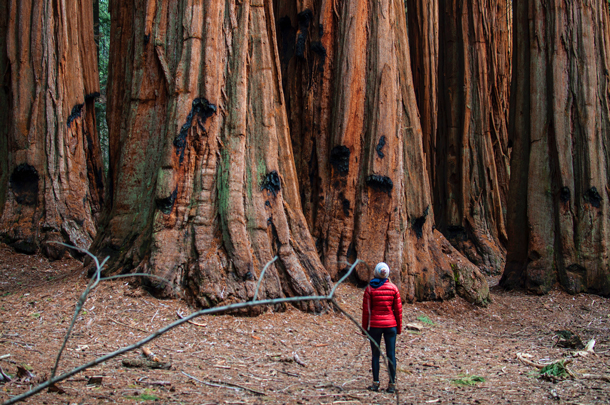
Giant sequoias are the largest trees on earth by volume, and with a lifespan of more than 3,000 years, they’re among the oldest. (Photo: Vitto Sommella on Unsplash)
BASCOMB: The latest installment in our “Exploring the Parks” series brings us to the ancient trees and jagged peaks of Sequoia and Kings Canyon National Parks. The two contiguous parks offer a huge diversity of habitats. At more than 14,500 feet, Mount Whitney is the tallest mountain in the contiguous US, and habitat for animals including pika, a mountain dwelling cousin of the rabbit….
[SFX PIKA SOUNDS]
BASCOMB: And bighorn sheep…
[SHEEP GRUNTS]
BASCOMB: Much lower, at just 2,000 feet, you can hear the dawn chorus at Big Oak Flat, featuring the dark eyed junco, oak titmouse, and the northern flicker.
[BIRD SOUNDS]
BASCOMB: Add in some of the largest trees in the world, the sequoias, and Sequoia and Kings Canyon National Parks have a lot to offer. Our guide to the parks is Savannah Boiano, the Executive Director of Sequoia Parks Conservancy. Welcome to Living on Earth!
BOIANO: Thank you, thank you for having me.
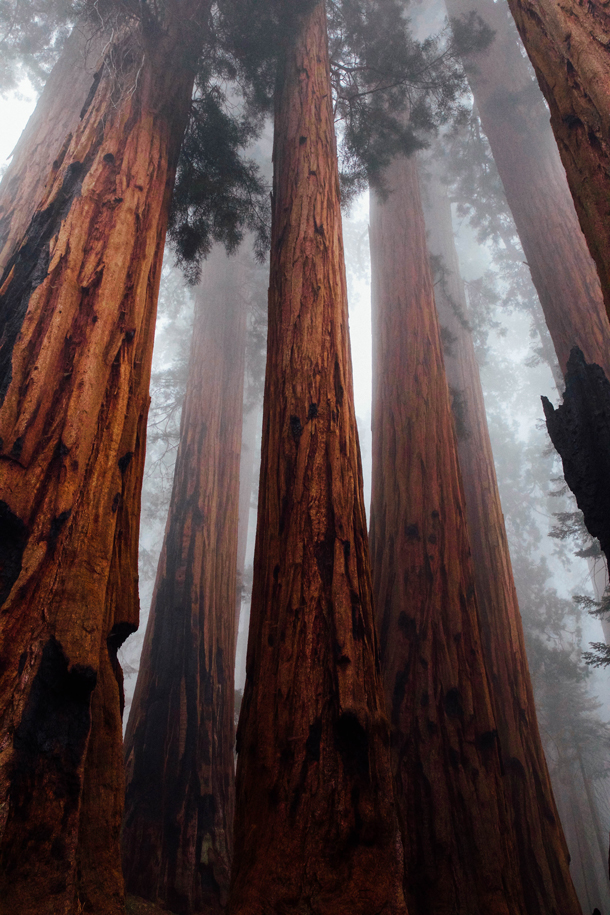
Giant sequoias shrouded in mist. (Photo: Victoria Palacios on Unsplash)
BASCOMB: For someone that's never been to either of the parks, can you sort of describe them before me, you know, paint a picture of what they look like there.
BOIANO: Oh gosh, they are stunning jewels. So Sequoia National Park and Kings Canyon National Park both lie in some of the steepest section of the Sierra Nevada. For those familiar with California, typically people are familiar with the Sierra Nevada kind of in regards to Tahoe or Yosemite National Park, and those landscapes were heavily glaciated, and they're more rounded and kind of more user-friendly in a lot of ways. And when you go south in the Sierra Nevada, things tend to get very, very steep. And so if you're looking at 14,000-foot peaks, Sequoia and Kings Canyon National Park have the majority of the 14,000-foot peaks for the Sierra Nevada, our highest being Mount Whitney. So Sequoia National Park starts at about 1,000 feet and goes up to 14,495 feet at Mount Whitney. And then Kings Canyon National Park starts in the, you know, 6000-foot range, goes up, and then goes precipitously down into a beautiful canyon; kind of rivals Grand Canyon as far as the depth of the canyon. So, we have a very dramatic landscape. And because of that dramatic landscape, it is considered an International Biosphere Reserve and it protects some of these beautiful life zones going from the foothills all the way up to the alpine regions.
BASCOMB: And I've read that there's over 800 miles of maintained trails in the parks, but the majority of them are only reachable by backpacking. What do you recommend for people that might be interested in doing something like that?
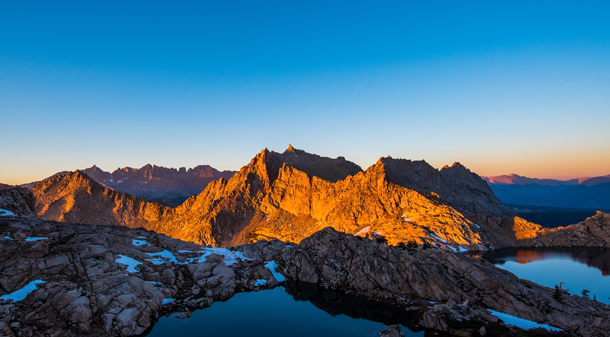
Spectacular views abound in the steep high country of Sequoia and Kings Canyon National Parks. (Photo: Siddharth Dedhia on Unsplash)
BOIANO: There are so many backpack trips here. The Rae Lakes loop in Kings Canyon National Park is very popular, you head out from Cedar Grove and walk from the end of a road all the way up into this beautiful subalpine valley with turquoise-colored lakes and wildflowers and a ranger station. There's one area actually, or a couple areas, where you can backpack into giant sequoia groves, and spend your night under those giants, looking up into those towering trees. And then in Sequoia National Park, some of the best backpacking, or most popular backpack spots, are out of the Giant Forest area which take you towards the Mount Whitney region, or even out of Mineral King where you're jumping off into the wilderness from about 8,000 feet and going up into the subalpine and alpine regions.
BASCOMB: It sounds like you have to be in pretty good shape; is this something that you think would be a family-friendly endeavor?
BOIANO: Yes, actually, you know, my husband and my daughter and I started backpacking the Sierra Nevada when she was four. We decided that she could go one mile per year of her life. So you know, she started off at four, and we went four miles for that day. And then we had a camping spot that we had picked out. And every year we add a mile to her age, and this year, we'll add a mile and we'll do, you know, 11 miles and that could be over, it'll probably be a day, but it could be over the course of two days. And then we'll find a backpack trip. So you know, some of it is with preparation before you come to the parks and knowing what your limits are. And knowing that you're going to be traveling at the speed and the ability of the least experienced or the slowest person in your group. And if you know all of those things beforehand, it can be very doable as long as you're kind of maintaining those expectations.
BASCOMB: So for somebody that's maybe not quite ready to hike the tallest mountain in the contiguous United States or you know, hike 11 miles with their child, is there something you can recommend for just a day or two, to sort of get a feel for the parks?
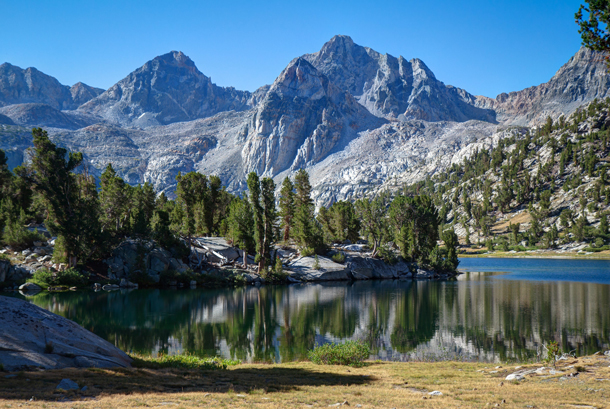
The Rae Lakes Loop is a popular backpacking route through Sequoia and Kings Canyon National Parks. (Photo: Flickr CC BY-NC 2.0)
BOIANO: Oh, my gosh, yeah. So of course, you want to come to these parks, and you want to check off some of the very popular features. And they're popular for a reason, because they're just stunning opportunities to experience, you know, America's national parks. So, I really like sending people to see the General Sherman tree. It is beautiful, and it's majestic, and you get a sense of perspective and size and your own size. And within the Giant Forest alone, you know, not only seeing the General Sherman tree, but there's 40 miles of walking trail just in that grove alone. Within that grove, you can hike up Moro Rock and stand perched above the giant sequoia grove and look down on that.
BASCOMB: Yeah, these trees are just so huge. It's almost, I think, hard to wrap your mind around the size of them, and the longevity.
BOIANO: Yeah, they're a sight to behold. You know, they're not the tallest trees in California, that distinction goes to the coast redwoods, where they are a full 10-story building taller than a giant sequoia. But when you get to the giant sequoia zone, those trees are much larger than their cousin, the coast redwood. They are bigger by volume, so they're a lot wider at their base. You know, for some of the monarch, the biggest at its base would be the General Grant tree. And the General Grant tree in Kings Canyon National Park, you could take a motor coach, park it lengthwise behind the General Grant tree and just make out the windshield wipers and the tailpipe.
BASCOMB: Wow, amazing. Now, I understand another thing that is popular in the parks is stargazing, and you are in a pretty good position for that. Can you tell me more?
BOIANO: Yeah. You can, whether you're staying at a park lodge or you're in the campground, or you're just, you know, late into the night, you can go on top of Moro Rock and on a full moon you can watch the full moon rise and the sun set, from that vantage point. It is a pretty cool experience. And then, you know, on a new moon, when everything is dark, you can be at one of our park lodges and go outside and just take a few steps from the lodge itself and look up and see really dark skies.
BASCOMB: Now, do you have a personal favorite, or a story that really stands out to you in your experience in the parks that you like to share with people? You know, a highlight of your experiences there?
BOIANO: Oh, I think you know, Moro Rock and watching the full moon rise over Moro Rock and watching the sunset is an incredible experience. I do tend to like backpacking myself; it just kind of takes me away from the office and technology and allows me to really spend some quality time with my family. And you know, we go nice and slow and enjoy the things along the way. Last year, you know, my daughter and I went up towards Hockett Meadow out of Mineral King. And we just took our time, and we found so many pika and chatted with them, and saw the birds. And so for me, going into the backcountry, it's not the distance, it's the journey of unhitching myself and my daughter from, you know, everyday life and just reconnecting, and I think that's one of the things that's great about Sequoia and Kings Canyon National Park. It's not as developed as other parks in California. And so it really is an opportunity to disconnect from things, and reconnect to those, you know, you're traveling with, or even yourself.
BASCOMB: Savannah Boiano is the Executive Director of Sequoia Parks Conservancy. Savannah, thank you so much for taking this time with me today.
BOIANO: Well, thank you for having me. It's been a pleasure.
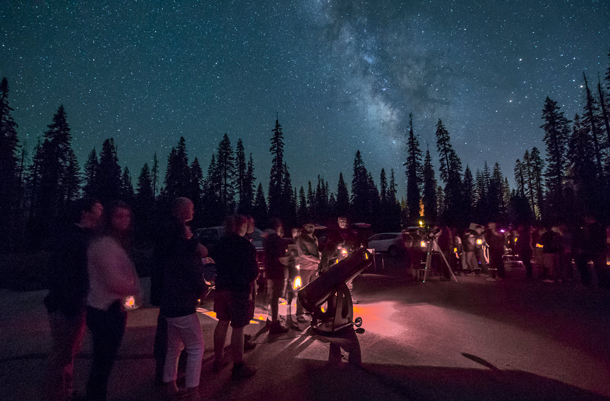
The Sierra Nevada mountains are a great place for stargazing, and Sequoia and Kings Canyon National Parks feature a Dark Sky Festival each August. (Photo: Cade Castle and Alison Taggart-Barone, courtesy of Sequoia Parks Conservancy)
[FOREST SOUNDS]
CURWOOD: We stay now in Sequoia and Kings Canyon National Parks in the company of black bears.
[BLACK BEAR HUFF]
CURWOOD: Black bears can make this huffing sound after being scared, akin to a sigh of relief.
[BLACK BEAR HUFF]
CURWOOD: In spring time black bears can be heard tearing apart logs looking for insects to eat.
[BLACK BEAR RIPPING LOG OR BLACK BEAR SCRATCHING LOG]
CURWOOD: These black bear recordings come to us courtesy of the National Park Service Soundscape Library.
And you can find a link to their audio recordings, interactive maps, and photos on our website, LOE.org
Related links:
- Plan your visit to Sequoia and Kings Canyon National Parks
- About the Sequoia Parks Conservancy
- The Sequoia & Kings Canyon 2019 Dark Sky Festival takes place August 23rd and 24th
- The Soundscape Library of Sequoia and Kings Canyon National Parks
- WATCH: "Exploring Soundscapes of Sequoia and Kings Canyon National Parks"
[MUSIC: Izzy Rosen, “Softly As In a Morning Sunrise” on Homeland Blues, by Oscar Hammerstein/Sigmund Romberg, Brownstone Records]
CURWOOD: Living on Earth is produced by the World Media Foundation. Our crew includes Naomi Arenberg, Diego Arenas, Paloma Beltran, Thurston Briscoe, Jenni Doering, Jay Feinstein, Merlin Haxhiymery, Don Lyman, Lizz Malloy, Aynsley O’Neill, and Jolanda Omari.
BASCOMB: Tom Tiger engineered our show. Alison Lirish Dean composed our themes. You can hear us anytime at LOE.org, iTunes and Google Play- and like us, please, on our Facebook page - PRI’s Living on Earth. We tweet from @livingonearth. And find us on Instagram at livingonearthradio. I’m Bobby Bascomb.
CURWOOD: And I’m Steve Curwood, Thanks for listening!
ANNOUNCER: Funding for Living on Earth comes from you, our listeners, and from the University of Massachusetts, Boston, in association with its School for the Environment, developing the next generation of environmental leaders. And from the Grantham Foundation for the protection of the environment, supporting strategic communications and collaboration in solving the world’s most pressing environmental problems. Support also comes from the Energy Foundation, serving the public interest by helping to build a strong, clean, energy economy.
ANNOUNCER 2: PRI, Public Radio International.
Living on Earth wants to hear from you!
Living on Earth
62 Calef Highway, Suite 212
Lee, NH 03861
Telephone: 617-287-4121
E-mail: comments@loe.org
Newsletter [Click here]
Donate to Living on Earth!
Living on Earth is an independent media program and relies entirely on contributions from listeners and institutions supporting public service. Please donate now to preserve an independent environmental voice.
NewsletterLiving on Earth offers a weekly delivery of the show's rundown to your mailbox. Sign up for our newsletter today!
 Sailors For The Sea: Be the change you want to sea.
Sailors For The Sea: Be the change you want to sea.
 The Grantham Foundation for the Protection of the Environment: Committed to protecting and improving the health of the global environment.
The Grantham Foundation for the Protection of the Environment: Committed to protecting and improving the health of the global environment.
 Contribute to Living on Earth and receive, as our gift to you, an archival print of one of Mark Seth Lender's extraordinary wildlife photographs. Follow the link to see Mark's current collection of photographs.
Contribute to Living on Earth and receive, as our gift to you, an archival print of one of Mark Seth Lender's extraordinary wildlife photographs. Follow the link to see Mark's current collection of photographs.
 Buy a signed copy of Mark Seth Lender's book Smeagull the Seagull & support Living on Earth
Buy a signed copy of Mark Seth Lender's book Smeagull the Seagull & support Living on Earth

